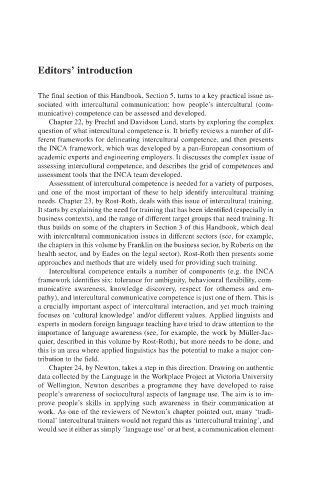Page 487 - Handbooks of Applied Linguistics Communication Competence Language and Communication Problems Practical Solutions
P. 487
Editors’ introduction 465
Editors’ introduction
The final section of this Handbook, Section 5, turns to a key practical issue as-
sociated with intercultural communication: how people’s intercultural (com-
municative) competence can be assessed and developed.
Chapter 22, by Prechtl and Davidson Lund, starts by exploring the complex
question of what intercultural competence is. It briefly reviews a number of dif-
ferent frameworks for delineating intercultural competence, and then presents
the INCA framework, which was developed by a pan-European consortium of
academic experts and engineering employers. It discusses the complex issue of
assessing intercultural competence, and describes the grid of competences and
assessment tools that the INCA team developed.
Assessment of intercultural competence is needed for a variety of purposes,
and one of the most important of these to help identify intercultural training
needs. Chapter 23, by Rost-Roth, deals with this issue of intercultural training.
It starts by explaining the need for training that has been identified (especially in
business contexts), and the range of different target groups that need training. It
thus builds on some of the chapters in Section 3 of this Handbook, which deal
with intercultural communication issues in different sectors (see, for example,
the chapters in this volume by Franklin on the business sector, by Roberts on the
health sector, and by Eades on the legal sector). Rost-Roth then presents some
approaches and methods that are widely used for providing such training.
Intercultural competence entails a number of components (e.g. the INCA
framework identifies six: tolerance for ambiguity, behavioural flexibility, com-
municative awareness, knowledge discovery, respect for otherness and em-
pathy), and intercultural communicative competence is just one of them. This is
a crucially important aspect of intercultural interaction, and yet much training
focuses on ‘cultural knowledge’ and/or different values. Applied linguists and
experts in modern foreign language teaching have tried to draw attention to the
importance of language awareness (see, for example, the work by Müller-Jac-
quier, described in this volume by Rost-Roth), but more needs to be done, and
this is an area where applied linguistics has the potential to make a major con-
tribution to the field.
Chapter 24, by Newton, takes a step in this direction. Drawing on authentic
data collected by the Language in the Workplace Project at Victoria University
of Wellington, Newton describes a programme they have developed to raise
people’s awareness of sociocultural aspects of language use. The aim is to im-
prove people’s skills in applying such awareness in their communication at
work. As one of the reviewers of Newton’s chapter pointed out, many ‘tradi-
tional’ intercultural trainers would not regard this as ‘intercultural training’, and
would see it either as simply ‘language use’ or at best, a communication element

